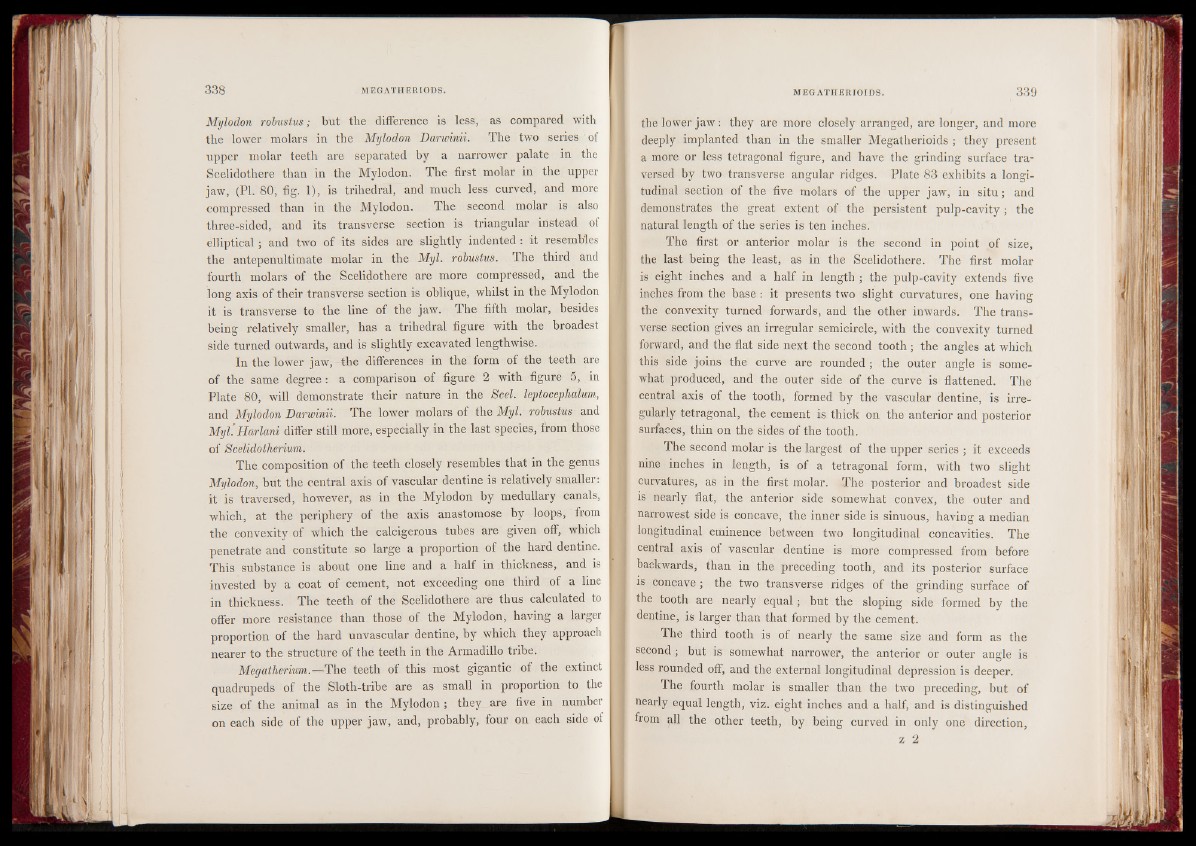
Mylodon robustus; but the difference is less, as compared with
the lower molars in the Mylodon Darwinii. The two series of
upper molar teeth are separated by a narrower palate in the
Scelidothere than in the Mylodon. The first molar in the upper
jaw, (PI. 80, fig. 1), is trihedral, and much less curved, and more
compressed than in the Mylodon. The second molar is also
three-sided, and its transverse section is triangular instead of
elliptical; and two of its sides are slightly indented : it resembles
the antepenultimate molar in the Myl. robustus. The third and
fourth molars of the Scelidothere are more compressed, and the
long axis of their transverse section is oblique, whilst in the Mylodon
it is transverse to the line of the jaw. The fifth molar, besides
being relatively smaller, has a trihedral figure with the broadest
side turned outwards, and is slightly excavated lengthwise.
In the lower jaw,-the differences in the form of the teeth are
of the same degree : a comparison of figure 2 with figure 5, in
Plate 80, will demonstrate their nature in the Seel, leptocephalum,
and Mylodon Darwinii. The lower molars of the Myl. robustus and
Myl. Harlani differ still more, especially in the last species, from those
of Scelidotherium.
The composition of the teeth closely resembles that in the genus
Mylodon, but the central axis of vascular dentine is relatively smaller:
it is traversed, however, as in the Mylodon by medullary canals,
which, at the periphery of the axis anastomose by loops, from
the convexity of which the calcigerous tubes are given off, which
penetrate and constitute so large a proportion of the hard dentine.
This substance is about one line and a half in thickness, and is
invested by a coat of cement, not exceeding one third of a line
in thickness. The teeth of the Scelidothere are thus calculated to
offer more resistance than those of the Mylodon, having a larger
proportion of the hard unvascular dentine, by which they approach
nearer to the structure of the teeth in the Armadillo tribe.
Megatherium.—The teeth of this most gigantic of the extinct
quadrupeds of the Sloth-tribe are as small in proportion to the
size of the animal as in the Mylodon; they are five in number
on each side of the upper jaw, and, probably, four on each side of
the lower jaw: they are more closely arranged, are longer, and more
deeply implanted than in the smaller Megatherioids ; they present
a more or less tetragonal figure, and have the grinding surface traversed
by two transverse angular ridges. Plate 83 exhibits a longitudinal
section of the five molars of the upper jaw, in situ; and
demonstrates the great extent of the persistent pulp-cavity; the
natural length of the series is ten inches.
The first or anterior molar is the second in point of size,
the last being the least, as in the Scelidothere. The first molar
is eight inches and a half in length ; the pulp-cavity extends five
inches from the base : it presents two slight curvatures, one having
the convexity turned forwards, and the other inwards. The transverse
section gives an irregular semicircle, with the convexity turned
forward, and the flat side next the second tooth; the angles at which
this side joins the curve are rounded ; the outer angle is somewhat
produced, and the outer side of the curve is flattened. The
central axis of the tooth, formed by the vascular dentine, is irregularly
tetragonal, the cement is thick on the anterior and posterior
surfaces, thin on the sides of the tooth.
The second molar is the largest of the upper series ; it exceeds
nine inches in length, is of a tetragonal form, with two slight
curvatures, as in the first molar. The posterior and broadest side
is nearly flat, the anterior side somewhat convex, the outer and
narrowest side is concave, the inner side is sinuous, having a median
longitudinal eminence between two longitudinal concavities. The
central axis of vascular dentine is more compressed from before
backwards, than in the preceding tooth, and its posterior surface
is concave; the two transverse ridges of the grinding surface of
the tooth are nearly equal; but the sloping side formed by the
dentine, is larger than that formed by the cement.
The third tooth is of nearly the same size and form as the
second; but is somewhat narrower, the anterior or outer angle is
less rounded off, and the external longitudinal depression is deeper.
The fourth molar is smaller than the two preceding, but of
nearly equal length, viz. eight inches and a half, and is distinguished
from all the other teeth, by being curved in only one direction,
z 2